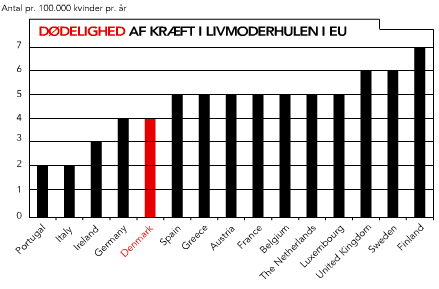UTERINE CANCER

Denmark has the 6th highest incidence and the 12th highest mortality caused by this type of cancer
Uterine cancer is one of the gynaecological types of cancer which is most commonly seen with older women. Worldwide, there are around 200,000 new cases every year. In Europe, there are around 40,000 new cases and almost 10,000 deaths caused by this type of cancer every year. Compared to all other countries in the EU, Denmark has the 6th highest incidence and the 12th highest mortality caused by this type of cancer. See the graph to the right.
It is the second most common type of gynaecological cancer after ovarian cancer. From 1943 to 1980 the annual number of diagnosed incidents has more than tripled.
In Denmark, the incidence of uterine cancer has been constant over the last 20 years with approx. 600 new cases a year.
Over the last decades, research has informed us of some of the causes of uterine cancer. With a small number of the women, we know that this type of cancer is hereditary because of modifications of some of their genes.
The most common cause is a high level of the female sex hormone, oestrogen. This hormone is produced in fat tissue which means an increased risk with overweight women.
Also women with the ovarian disease PCO (Poly Cystic Ovarian Syndrome) and patients with diabetes have an increased risk of developing the disease.
Unlike the other types of gynaecological cancer, uterine cancer often shows symptoms at an early stage, before it has spread to other organs.
 Most women begin bleeding from the uterus to the vagina. The disease can then be diagnosed by gynaecological examinations. Around 70% are diagnosed with the cancer at an early stage of the disease, whereas around 30% are diagnosed only when it has spread.
Most women begin bleeding from the uterus to the vagina. The disease can then be diagnosed by gynaecological examinations. Around 70% are diagnosed with the cancer at an early stage of the disease, whereas around 30% are diagnosed only when it has spread.
When the cancer is found at an early stage, there is a good prognosis of survival which after surgery is not considerably different from women without cancer. Based on the Danish figures, the 5-year survival at the early stage is more than 90%, whereas it is at the later stages from 60% to 40%. Therefore, it is important to diagnose the cancer whilst the disease is localized to the uterus.
Even though this type of cancer has a better prognosis than the other types of gynaecological cancer, it is still necessary to research the disease.
Research combined with population studies (epidemiology), the newest techniques in laboratories (bio-chemical and genetic) together with new methods of treatment (surgery and oncological treatment) are expected to increase the quality of life and improve the prognosis in the future.
Read more about uterine cancer on www.cancer.dk
Read more about the treatment of uterine cancer on www.dgc-dk.dk
Read more about Ovarian cancer Read more about Cervical cancer